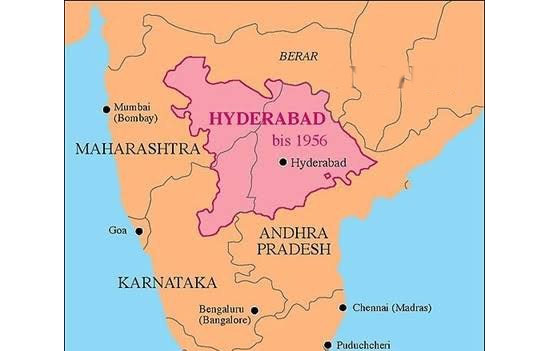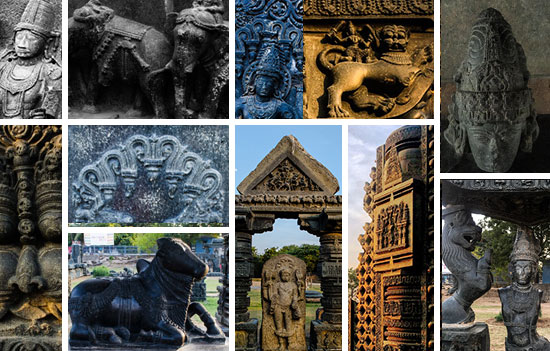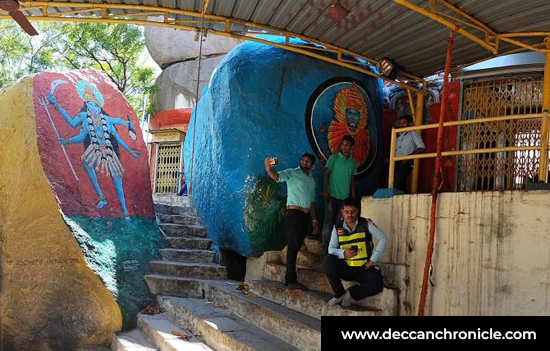- This
FAQ tells why Sept 17 should be celebrated as Hyderabad Liberation Day, role of
Arya Samaj in liberation of Hyderabad & why were Hindus unhappy under Nizam
Rule? Lastly, what happened in 1947 includes Accession of State, objectives of
MIM, role of Razakars and Operation Polo.
The
Central government declared September 17 would be celebrated as Hyderabad State
Liberation Day. TRS declared it as ‘Telangana National Unity Day’. MIM leader Owasi said day should be celebrated as National Integration Day, “The struggles of the people of the erstwhile Hyderabad state against colonialism, feudalism and autocracy are a symbol of national integration rather than merely a case of "liberation" of a piece of land.” What should it be ? Read on.
While
virtually all areas (about 560 Princely States and British India) became part
of India on August 15, 1947 the people of Hyderabad State got freedom, from
Nizam rule, only in September 1948.
At
Independence Madras Presidency included Rayalaseema and Coastal Andhra. “In
1952, Dr. Burgula Ramakrishna Rao was elected chief minister of the Hyderabad
State in its first democratic election.” Freedom fighter Potti Sreeramulu’s 56
day hunger-strike and death to draw attention to demand for a state of Telegu
speaking regions of Madras resulted in the formation of Andhra Pradesh in 1953.
The newly formed Andhra Pradesh was merged with the Telegu speaking areas of Hyderabad
State in 1956. The current Telangana
state was formed on June 2, 2014.
Note that the Hyderabad State ruled by Nizams (Asif Jahi
Dynasty, 1724 to 1948) covered three linguistic areas in modern day Telangana,
Maharashtra (Marathwada) and Karnataka. Marathwada areas include districts of Aurangabad,
Beed, Hingoli, Jalna, Latur, Nanded, Osmanabad and Parbhani and districts of
Kalaburagi, Bellary, Raichur, Yadgir, Koppal, Vijayanagara and Bidar in today’s
Karnataka.
 Map of Hyderabad State shows parts of Maharashtra, Karnataka.
Map of Hyderabad State shows parts of Maharashtra, Karnataka.
Q1 Why does Marathwada celebrate September 17 as Marathwada
Liberation Day or Marathwada
Mukti Sangram Din?
A1. Since the Nizam rule came to an end on September 17, it is celebrated as Liberation Day. The Mukti Sangram Din is a tribute to those who fought against Nizam rule under the leadership of Swami
Ramanand Tirth, Govindbhai
Shroff, Vajayantra Kabra, P H Patwardhan and others. Source
Q2. Can September 17 be National Integration Day as stated by
Owasi?
A2. India was liberated from British rule on August 15, 1947. The process of integration of British India and Princely States started then. For certain reasons the integration of Hyderabad State etc. happened later. People fought for freedom from Nizam’s rule. The Razakars wanted Muslim rule (under Nizam) to continue for e.g. “On August 27, 1948, Razakars killed 96 villagers in Bhairanapally to quell their demand for merger with India.” Source
According to a White Paper on Hyderabad published by Government of India, “A special feature of the history of Hyderabad has been that not only did it never enjoy independence but it also never established a legitimate claim to it by making any sacrifices in the cause of independence.” Also, “the Nizam's Government lifted the 5 year old ban on the Communists & efforts are being made for an Ittehad-Communist alliance to make common cause against India.” 7
 Temple in Warangal Fort destroyed by Muhammad-bin-Tughlaq in 1323.
Temple in Warangal Fort destroyed by Muhammad-bin-Tughlaq in 1323.
Q3. What is role of the Arya Samaj in the liberation from Nizam
rule?
A3. Sri Ram Sharma wrote in A History of the
Arya Samaj, “The Arya Samaj launched a
successful Satyagraha against the Nizam of Hyderabad in 1939 and delivered such
a shattering blow to his prestige that he was never able to recover his former
status, atleast in the eyes of his subjects.” Pg. 203
Here
is a quote from the DAV College Solapur site, “Dayanand Anglo
Vedic (DAV) College Trust and Management Society, New Delhi established Damani
Bhairuratan Fatehchand Dayanand College of Arts and Science, Solapur on 17th
June 1940 in memory of the victory of Satyagraha launched by Arya Samaj against
the Nizam of Hyderabad as a part of `Marathwada Mukti Sangram’.”
Smt H Geeta (and others), Associate Prof in B.J.R. Government Degree College, Hyderabad wrote in Role of Arya Samaj in the Liberation of
Hyderabad State, “During the reign of VII Nizam Mir Osman Ali Khan the last
ruler, political awakening and Public Opinion began among the people, this took
place mainly because of the activities of Arya Samaj. Several restrictions were
imposed on the activities of Arya Samaj like the holding Nagar Kirtans,
hoisting Om flags and so on. When Nizam Government offered education only in
Urdu Medium attempt were made to start ‘Raastriya’ School. Under the president
ship of Pandit Rao Koratkar in 1932 branches of Arya Samaj were established
throughout state and education spread through libraries and schools in
Marathwada. The students of Intermediate College Aurangabad, under the guidance
of G.M. Shroff started The Vande Mataram Movement in 1938 and Shroff resigned
as teacher and helped organise it.” 3
Q4. Why were Hindus protesting against Nizam rule?
A4.
Here are some reasons.
1. Dr Satish K Kapoor,
Local Secretary of Dayananda institutions, Solapur (2008 to 2012) and former British
Council Scholar says that Arya Samajis were not allowed to perform havan in their homes.
2. Dr Gautam
Pingle, Dean of Studies & Head, Centre for Telangana Studies, MCR-HRD
Institute of Telangana wrote about the land tax in The Formation and History of Telangana: A Collection of Nine Critical
Essays, “The Hindu canonical land tax was fixed by Bhishma in his
instruction to Yudhishthira in the Mahabharata to take “a sixth part, upon fair
calculation, of the yield of the soil as his tribute.” (Ganguli 2003 Volume
VIII: 156).This was the famous shadbaga
and applied over time. Even Akbar’s minister Abul Fazl attested to the
continuity of the one-sixth rate: “Throughout the whole extent of Hindustan
where at all times so many enlightened monarchs have reigned, one-sixth of the
produce was exacted.” (Abul Fazl Allami, 1891:55). The Mohammedan Kings,
however, following Islamic law made a distinction between believers and
non-believers. The Islamic canonical land tax as
per sharia was fixed at 50% for non-Muslims and 10% for Muslims.” The
British reduced the level of tax to a rational number.
3. “Muslims constituted less
than 15% of the population but held 75% of positions in the bureaucracy.” 6 Also referred to in 7
4. Faisal CK wrote
in The Wire, “The Vande
Mataram movement was the most significant movement in the
history of Hyderabad’s freedom struggle. The Nizam’s government forbade the
singing of ‘Vande Matram’ all over the state, including in educational
institutions and hostels. It became a symbol of nationalist agitation. The MIM
supported the Nizam’s adamant action against this movement.” 6
5. Excerpts from White Paper, “Hyderabad of today, on the other hand, is not only a stronghold of mediaeval feudalism but also a plague spot of militant fascism and communal fanaticism. The political structure of Hyderabad is the very antithesis "of democracy; the Razakar ideology, which dominates Hyderabad", is automatically and irrevocably against popular freedom and democratic concepts.” 7
Q5. Since Hyderabad was a
Muslim ruled state should it have become part of Pakistan?
A5. Lt Gen N S Malik
wrote in the Indian Defence Review, “Similarly
the so called “Two Nation Theory”, under whose umbrella Pakistan was formed,
applied only to British ruled India and not the princely states, and hence a
state being Muslim majority did not disqualify it from joining Indian Union.
(Note that Kapurthala in Punjab was a
Muslim Majority State)”. 5
 Mahakali Temple at Golconda Fort
Mahakali Temple at Golconda Fort
Q6. What happened in 1947?
A6. Prior to partition in 1947, British rule over India comprised two separate geographical regions. One comprised of various provinces administered by the Viceroy of India (referred to as British India). The other comprised provinces ruled by Maharajas, Princes, Nawabs etc. There were 562 Princely states of which 327 were petty states.
On 20/2/1947, His Majesty's Government announced that British India would become independent. Facing the state’s rulers on 11/7/1947 Mountbatten said, ‘The Indian Independence Act releases the States on 15th August from all their
obligations to the Crown. The States have complete freedom-technically and
legally they are independent’. At a meeting held on 25/7/1947 Mountbatten
advised the princes that they should accede to one of the two dominions,
keeping in mind the ‘geographical contiguity of their States’.
Kashmir, Hyderabad were two big states
that had not signed the Instrument of Accession (IOA) by 15/8/1947. Kashmir
signed by IOA on 26/10/1947.
In Hyderabad State Muslims controlled the
army and public service. The British had refused to consider Nizam’s plea for
Dominion status. Patel had given the Nizam three months, after August 15, to
decide. No accession, no Standstill Agreement was India’s policy. The agreement
was signed on November 29, 1947. Amongst others, it provided for posting an
Agent-General in each other’s headquarters. India appointed K M Munshi. Assured
that Nizam would not join Pakistan and aware that Nizam was lending his ear to
extremist Muslims, Patel decided to wait. He also knew that Mountbatten would
return in the summer of 1948. 1 Patel A Life by Rajmohan Gandhi
The Nizam was under the influence of a
young man Kasim Razvi who headed Ittehad-ul-Musilmeen, a body dedicated to
maintaining Muslim supremacy in the State. The Razakars formed the Ittehad’s
militant wing. Faisal wrote, “Formed in 1926, the MIM had a 4-fold objective: maintain
Hyderabad as an independent Islamic monarchy under the Asaf Jahi dynasty,
perpetuate Muslim dominance in the bureaucracy, keep Urdu as the official
language and prevent the formation of a popular, responsible government.” 6
Razvi visited Delhi himself in November
and told Sardar Patel, “We shall fight and die to the last man.” V P Menon
noticed his fanaticism bordering on frenzy. 1 Pg. 476 Faisal wrote, “After Operation Polo, the MIM was banned in 1948. Qasim
Razvi was jailed from 1948 to 1957, and was released on the condition that he
would go to Pakistan where he was granted asylum. Before leaving, Razvi handed
over the responsibility of the Ittehadul Muslimeen, to Abdul Wahid Owaisi,”
grand-father of the current Owasi leader.
Patel told Nizam representative Laik Ali that India
would restrain itself if Hindus were given a say in the government. Democracy
was unacceptable to the Nizam and those guiding him. “They arranged a secret
loan of Rs 20 crs to Pakistan, whose support was essential if the Nizam were to
stand up to India. The Razakars were
financed and armed”. 1 Pg. 476
The Nizam complained in April 1948 to the British of an economic blockade (Patel had a heart attack around this time). Razvi gave speech in which he said, “The 45 million Muslims in the Indian Union would be our 5th column in any
showdown”. 1 Pg 477 The provincial
governments of Bombay, Central Provinces and Madras had given reports of
Razakar lawlessness on the border.
Due to numerous efforts Patel initialled
The Heads of Agreement. It provided that the Nizam’s Government, if requested
by New Delhi, would pass legislation similar to India in the matters of
defence, foreign affairs and external communications. Further the Hyderabad
Army would be limited to a maximum of 20,000, Razakars would be gradually
disbanded. Also the Nizam would declare that he would hold a plebiscite, form a
Constituent Assembly with leaders of major political parties. 1
When Laik Ali reached Hyderabad with the
initialled copy the Nizam and his advisors had a new set of demands. Aware this
would happen Patel convinced the Cabinet in May 1948 to authorise preparations
for military action.
Mountabatten left on June 21 and Patel had
returned from Dehradun (recovery from illness). Now the economic blockage
became official and tighter. “Hyderabad played into his hands by hiring gun-runners who were taking off at night from airports in Pakistan and touching down on landing strips in Bidar and Warangal.” 1 Pg 481 Patel A Life by Rajmohan Gandhi
Razakars and Communists appeared to be
forging close links. In July 1948, a Hindu member of Nizam’s council Shri Joshi
resigned, charging the police and Razakars for jointly terrorising Hindus in
Hyderabad’s western districts. 1 (for
details of atrocities see pg. 55 of 7). Violence against Hindus invited military action by India.
Jinnah died on August 11, 1948. Operation
Polo started on the dawn of the 13th. Razakar resistance was stiffer
than the State troops. It was all over by the 17th evening. “Razakar
figures were 2727 killed, 3364 captured. Indian casualties were 42 killed and
24 missing”. 1
 Undivided Andhra Pradesh produces quality handlooms even today.
Undivided Andhra Pradesh produces quality handlooms even today.
Major General Chaudhari took over on
September 18 as Military Governor. Nizam was appointed as a constitutional
head. Post defeat the Nizam withdrew the complaint to the United Nations,
disowned the Razakars amongst others.
Since India defeated Hyderabad State on
September 17 resulting in it becoming part of India, the date assumes
significance.
It is important for Hindus of today to
realize what life under Muslim rule can be.
References
1. Patel A Life by Rajmohan Gandhi
2.
Year-long
liberation celebration
3. Role of Arya Samaj in the liberation of Hyderabad State. To download PDF click on PDF
4.
All
you wanted to know about the accession of J&K to India
5.
Solution
to J&K problem lies in New Delhi
6.
The
early MIM was a great defender of Nizam’s communalism & feudalism
7. White Paper on Hyderabad State by Government of India.
Also read
1.
A
brief history of the Nizam of Hyderabad
2.
Arya Samaj
Movement in the erstwhile Hyderabad State 1938-39
3.
Arya
Samaj and DAV Movement – Social and Educational Dimensions
4.
Border Movement in Hyderabad Karnataka for Liberation and Integration (1947-48).
5.
When
Razvi’s Pakistan born grand-daughter visited Hyderabad
6.
Hidden
history of the Owasis – what MIM does not want you to know
7.
Look
back in denial
8.
Temple
in Warangal Fort
This
article must not be republished without the written permission of www.esamskriti.com